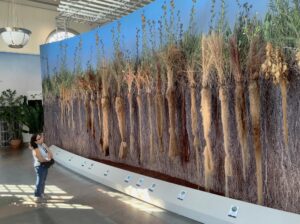Native grasses are an essential topic that many don’t consider. Many of the green pasture grasses you see today are actually from other countries and contain 10x the amount of chemicals as farmland.(1)
Native grasses are more cost-efficient as they require far less maintenance and promote beneficial wildlife. Natives have existed in the ecological landscape for so long that they have adapted to the soil, terrain, sunlight, and moisture conditions. This means homeowners won’t waste as much time and money watering, cutting, or reseeding. Reseeding is a natural aspect of native grasses because they are perennial which means they self-seed each year. They are more prepared to deal with natural droughts because their roots reach far, far down into the ground (see photo). This also means native grasses are beneficial for soil erosion; plant native grasses near pond edges and more. Their far-reaching roots also assist in maintaining healthy soil. Furthermore, native grasses are naturally resistant to many of the local pests and diseases that many homeowners would usually treat with pesticides. Not only does using fewer pesticides save you money but it also means a healthier ecosystem – less poison means more pollinators, healthier soil, and less chemical runoff that can affect human and animal lives.
Learn more about native grasses, groundcover, and lawngrasses HERE at the UF|IFAS extension website.
